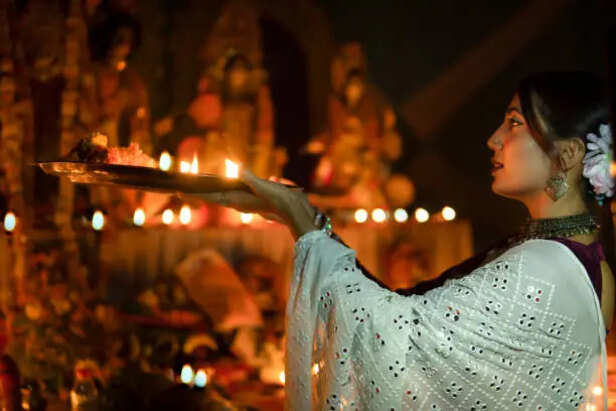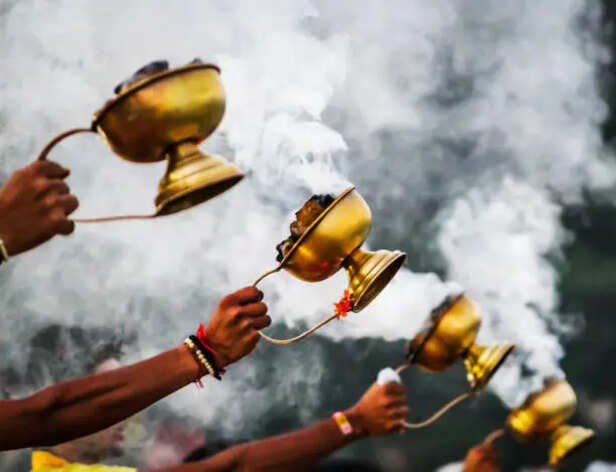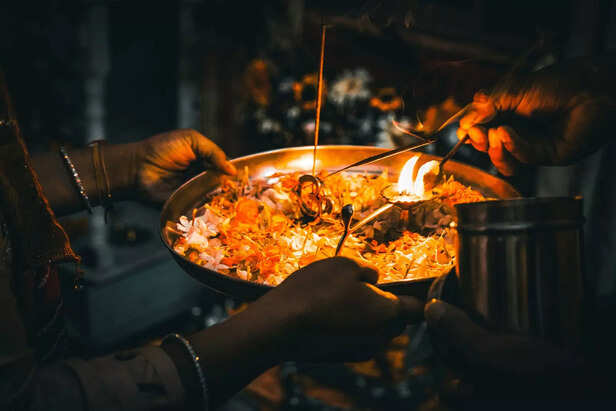Why Hindus Perform Aarti Clockwise Secret Revealed!
Trisha Chakraborty | Times Life Bureau | Sep 18, 2025, 08:00 IST
Aarti flows with the rhythm of the universe.
( Image credit : Unsplash )
Aarti is one of the most cherished rituals in Hindu worship, and its clockwise motion has deep meaning beyond tradition. The circling flame reflects the natural order of the universe, the sanctity of the right side, and the forward movement of life itself. It symbolizes the flow of divine energy, the spreading of light, and harmony with creation. This timeless practice not only honors the deity but also offers lessons for daily living move forward, stay in rhythm with nature, and share your light with others. The clockwise aarti remains both a spiritual act and a guide for life.
If you have ever participated in evening prayer at a Hindu temple, you recognize the moment. The candles flicker, bells peal out in harmony, incense wafts through the air, and a priest starts moving in a circle about the flame before the god. Never fails to be clockwise. So ingrained that none of us ever take a moment to wonder: Why clockwise only? Never counterclockwise? This is the one that leads us into the very centre of Hindu tradition, where rituals need not be just form. They are painstakingly created to mirror nature, philosophy, and the human psyche. The aarti clockwise is a case in point appearing simple, yet replete with meaning.

The sun rises in the east and sets in the west, and seems to travel around the sky in a clockwise direction. The earth similarly turns in the same direction. Even our clocks, with the motion of the sun, turn in the same direction. When the flame spins in the clockwise direction, it's as if prayer is moving in harmony with the world. It's not merely a matter of exercising respect to the god it's about harmonizing human movement with the natural direction of time and creation. It would be as if resisting that beat to be moving in the opposite direction.
In Hindu culture, the right-hand side is extremely significant.
• Take devoted pilgrims circumambulating temples in the clockwise direction with the god remaining on their right-hand side.
• Traditionally, blessing and gift is conferred with the right hand.
In moving the flame to the right, that is, clockwise, the priest ensures that the deity is always kept to the right i.e., honor, respect, and good fortune. The opposite direction would reverse this symbolism and is hence eschewed.

Visualize aarti as progressive prayer. Every round of the lamp is like a life cycle in itself.
Clockwise motion symbolizes continuity, growth, and going ahead in a positive direction. Anti-clockwise movement is usually associated with reversal or unwinding.
This is why the flame never turns back: it is an unconscious reminder that life has to always go ahead, regardless of challenges.
The Flow of Energy and Blessings
And there is a metaphysical reason too, based on the direction of energy.
•The rightward flame is allegedly drawing divine energy from the deity.
•It directs that energy outward in a circle to everyone who is present.
•Recently, individuals receive it by applying the warmth of the flame to their eyes or forehead.
This cycle divinity to flame, flame to congregation is sacred. To change the direction of the flow would be to short-circuit that current.

The aarti flame is not just a physical light. It is sanctity, illumination, and triumph of truth over darkness. By moving the lamp in a clockwise direction, the light symbolically shines in every direction, touching every end of the temple as well as every single devotee present there. The movement has a soft lesson: benevolence and wisdom shouldn't stay within themselves; they need to go out, spreading blessings to others.
Albeit unexpectedly, this counterclockwise activity is not exclusive to Hinduism.
• Buddhists proceed in a clockwise direction around stupas.
• Sikhs employ clockwise directions in certain rituals.
• Even Christian processions tend to go in one direction when they have candles to carry.
It would appear that worldwide, clockwise has become the sign of order, respect, and adherence to higher truths.
Aside from philosophy, the clockwise aarti has one purely human consequence: it soothes us. Observing the flame travel in a smooth, rhythmic motion is intensely grounding.
• The repetition provides a meditative rhythm.
• The predictability comforts the mind and dispels restlessness.
• The group movement brings everyone together, creating a shared enthusiasm.
That is why human beings instinctively tell us that aarti is calming, although they are not aware of its symbolism. It is not so much a matter of faith, but of the cadence of the human heart.
 The aarti tradition in the circular manner has lessons beyond the temple:
The aarti tradition in the circular manner has lessons beyond the temple:
• Move in the rhythm of life: March with nature and not against it.
• Go ahead: Similar to how the flame bobs back and forth in front, continue going forward in life, even troubles.
• Share your light: Similar to the lamp that shares its goodness with everyone, share your knowledge, goodness, and kindness with others.
These are lessons demonstrating how Hindu rituals are not merely insignificant offerings to God but also teachings on living well as well.
Today, rituals are used interchangeably with the traditional. Yet, the clockwise aarti remains important as it is not just a ritual it is a multi-sense experience.
• Sight: the soft flame.
• Sound: the calming bells and chanting.
• Olfactory: incense and newly opened flowers.
• Feel: the heat of the lamp passed on to the forehead.
• Taste: the prasad distributed afterwards.
The counterclockwise flame is the thread that binds this all together. It takes a mundane occurrence and raises it to the level of unity, contemplation, and peace.
Then why is it that Hindus always do aarti in the clockwise direction? Because the direction is not merely of significance. It symbolizes the sun's and earth's direction. It respects the divine right side. It permits blessings to move freely. It distributes light to all ends. And maybe most of all, it shows us the path to progress in life, in co-ordination with creation.
Each turn of the flame is more than ritual it's a reminder:
•Stay in balance with the universe.
•Proceed with optimism.
•Release your light to the world.
So the clockwise aarti is more than worship of the divine. It is an ageless, timeless principle on living in harmony, awe, and purpose.
Explore the latest trends and tips in Health & Fitness, Spiritual, Travel, Life Hacks, Trending, Fashion & Beauty, and Relationships at Times Life!
Flowing With the Rhythm of the Universe
One of the most obvious reasons lies in nature itself.

Clockwise Aarti: A Hindu Ritual Explained
( Image credit : Unsplash )
The sun rises in the east and sets in the west, and seems to travel around the sky in a clockwise direction. The earth similarly turns in the same direction. Even our clocks, with the motion of the sun, turn in the same direction. When the flame spins in the clockwise direction, it's as if prayer is moving in harmony with the world. It's not merely a matter of exercising respect to the god it's about harmonizing human movement with the natural direction of time and creation. It would be as if resisting that beat to be moving in the opposite direction.
The Right Side as It Relates to Hinduism
• Take devoted pilgrims circumambulating temples in the clockwise direction with the god remaining on their right-hand side.
• Traditionally, blessing and gift is conferred with the right hand.
In moving the flame to the right, that is, clockwise, the priest ensures that the deity is always kept to the right i.e., honor, respect, and good fortune. The opposite direction would reverse this symbolism and is hence eschewed.
Forward, Not Backward

The Symbolism Behind Clockwise Aarti
( Image credit : Unsplash )
Visualize aarti as progressive prayer. Every round of the lamp is like a life cycle in itself.
Clockwise motion symbolizes continuity, growth, and going ahead in a positive direction. Anti-clockwise movement is usually associated with reversal or unwinding.
This is why the flame never turns back: it is an unconscious reminder that life has to always go ahead, regardless of challenges.
The Flow of Energy and Blessings
•The rightward flame is allegedly drawing divine energy from the deity.
•It directs that energy outward in a circle to everyone who is present.
•Recently, individuals receive it by applying the warmth of the flame to their eyes or forehead.
This cycle divinity to flame, flame to congregation is sacred. To change the direction of the flow would be to short-circuit that current.
Light That Spreads, Not Stays

“Each circle connects us to creation’s order.”
( Image credit : Unsplash )
The aarti flame is not just a physical light. It is sanctity, illumination, and triumph of truth over darkness. By moving the lamp in a clockwise direction, the light symbolically shines in every direction, touching every end of the temple as well as every single devotee present there. The movement has a soft lesson: benevolence and wisdom shouldn't stay within themselves; they need to go out, spreading blessings to others.
A Shared Practice Across Cultures
• Buddhists proceed in a clockwise direction around stupas.
• Sikhs employ clockwise directions in certain rituals.
• Even Christian processions tend to go in one direction when they have candles to carry.
It would appear that worldwide, clockwise has become the sign of order, respect, and adherence to higher truths.
Calming the Mind, Anchoring the Heart
• The repetition provides a meditative rhythm.
• The predictability comforts the mind and dispels restlessness.
• The group movement brings everyone together, creating a shared enthusiasm.
That is why human beings instinctively tell us that aarti is calming, although they are not aware of its symbolism. It is not so much a matter of faith, but of the cadence of the human heart.
A Lesson of Gentle Wisdom for Daily Life

The flame moves forward, just like life
( Image credit : Unsplash )
• Move in the rhythm of life: March with nature and not against it.
• Go ahead: Similar to how the flame bobs back and forth in front, continue going forward in life, even troubles.
• Share your light: Similar to the lamp that shares its goodness with everyone, share your knowledge, goodness, and kindness with others.
These are lessons demonstrating how Hindu rituals are not merely insignificant offerings to God but also teachings on living well as well.
Why It Still Matters Today
• Sight: the soft flame.
• Sound: the calming bells and chanting.
• Olfactory: incense and newly opened flowers.
• Feel: the heat of the lamp passed on to the forehead.
• Taste: the prasad distributed afterwards.
The counterclockwise flame is the thread that binds this all together. It takes a mundane occurrence and raises it to the level of unity, contemplation, and peace.
Conclusion
Then why is it that Hindus always do aarti in the clockwise direction? Because the direction is not merely of significance. It symbolizes the sun's and earth's direction. It respects the divine right side. It permits blessings to move freely. It distributes light to all ends. And maybe most of all, it shows us the path to progress in life, in co-ordination with creation.
Each turn of the flame is more than ritual it's a reminder:
•Stay in balance with the universe.
•Proceed with optimism.
•Release your light to the world.
So the clockwise aarti is more than worship of the divine. It is an ageless, timeless principle on living in harmony, awe, and purpose.
Explore the latest trends and tips in Health & Fitness, Spiritual, Travel, Life Hacks, Trending, Fashion & Beauty, and Relationships at Times Life!
